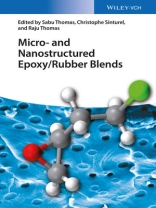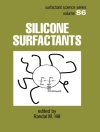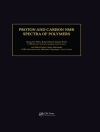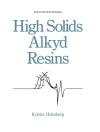Epoxy resins are polymers which are extensively used as coating materials due to their outstanding mechanical properties and good handling characteristics. A disadvantage results from their high cross-link density: they are brittle and have very low resistance to crack growth and propagation. This necessitates the toughening of the epoxy matrix without impairing its good thermomechanical properties. The final properties of the polymer depend on their structure. The book focuses on the microstructural aspects in the modification of epoxy resins with low molecular weight liquid rubbers, one of the prime toughening agents commonly employed.
The book follows thoroughly the reactions of elastomer-modified epoxy resins from their liquid stage to the network formation. It gives an in-depth view into the cure reaction, phase separation and the simultaneous development of the morphology. Chapters on ageing, failure analysis and life cycle analysis round out the book.
Inhoudsopgave
Preface XV
List of Contributors XVII
1 Introduction 1
Raju Thomas, Christophe Sinturel, Sabu Thomas, and Elham Mostafa Sadek El Akiaby
1.1 Epoxy Resin – Introduction 1
1.2 Cure Reactions 1
1.3 Curing Agents 2
1.3.1 Catalytic Cure 3
1.3.2 Co-reactive Cure 3
1.4 Different Curing Methods 7
1.4.1 Thermal Curing 7
1.4.2 Microwave Curing 8
1.4.3 Radiation Curing 10
1.5 Curing of Epoxy Resins: Structure–Property Relationship 12
1.6 Toughening of Epoxy Resin 13
1.6.1 Different Toughening Agents 13
1.7 Rubber-Modified Epoxy Resin: Factors Influencing Toughening 16
1.7.1 Concentration Effects 16
1.7.2 Particle Size and Distribution of Rubber 16
1.7.3 Effect of Temperature 17
1.7.4 Effect of Rubber 17
1.7.5 Interfacial Adhesion 18
1.8 Toughening Mechanisms in Elastomer-Modified Epoxy Resins 18
1.8.1 Particle Deformation 18
1.8.2 Shear Yielding 19
1.8.3 Crazing 20
1.8.4 Simultaneous Shear Yielding and Crazing 21
1.8.5 Crack Pinning 22
1.8.6 Cavitation and Rumples 22
1.9 Quantitative Assessment of Toughening Mechanisms 23
1.10 Introduction of Chapters 24
References 25
2 Liquid Rubbers as Toughening Agents 31
Hanieh Kargarzadeh, Ishak Ahmad, and Ibrahim Abdullah
2.1 Introduction 31
2.2 Toughening of Thermoset Resins 31
2.3 Fracture Behavior of Rubber-Toughened Thermosets 32
2.4 Natural Rubbers 35
2.4.1 Preparation Method of LNR 36
2.5 Liquid-Toughening Rubber in Thermoset Resins 43
2.6 Concluding Remarks 49
References 50
3 Nanostructured Epoxy Composites 53
Yuan Meng and Xinghong Zhang
3.1 Introduction 53
3.2 Preparation Methods of the Nanostructured Epoxy Thermoset 54
3.3 Morphology of the Nanostructured Epoxy Thermoset 56
3.3.1 Parameters Controlling the Morphologies 56
3.4 Microphase Separation Mechanism 60
3.4.1 Self-Assembly Mechanism 61
3.4.2 Reaction-Induced Microphase Separation Mechanism 63
3.5 Mechanical and Thermal Properties 65
3.5.1 Fracture Toughness 65
3.5.2 Glass Transition Temperature 67
3.6 Conclusions and Outlooks 67
References 68
4 Manufacture of Epoxy Resin/Liquid Rubber Blends 73
Sahrim Bin Hj Ahmad, Mimi Azlina Abu Bakar, Ying Yi, and Qi Qin
4.1 Introduction 73
4.2 Comparison of Hardeners 74
4.3 Rubber-Toughened Epoxy Resins 77
4.4 Cure Reaction Analysis 79
4.5 Conclusions 79
References 80
5 Cure and Cure Kinetics of Epoxy-Rubber Systems 83
Humberto Vázquez-Torres
5.1 Introduction 83
5.2 Cure Analysis 83
5.3 Curing Kinetics 84
5.3.1 Kinetics Analysis 85
5.3.2 Autocatalytic Model 85
5.3.3 Activation Energies 86
5.4 Diffusion Factor 88
5.5 Differential Scanning Calorimetry 88
5.5.1 Dynamic DSC 89
5.5.2 Isothermal DSC 90
5.6 FTIR Spectroscopy 92
5.7 Dielectric Spectroscopy Thermal Method 94
5.8 Pressure–Volume–Temperature (PVT) Method 96
5.9 Dynamic Mechanical Analysis (DMA) and Rheological Methods 97
5.10 Conclusions 101
Acknowledgments 101
References 101
6 Theoretical Modeling of the Curing Process 105
Nicolas Boyard, Vincent Sobotka, and Didier Delaunay
6.1 Introduction 105
6.2 Modeling of the Curing Kinetics 106
6.2.1 Mechanistic Approach 107
6.2.2 Phenomenological Models Describing the Reaction 109
6.2.3 Rheological Models 118
6.2.4 Effect of Vitrification (Tg ) on the Reaction Rate 119
6.3 Applications of the Empirical Models 120
6.4 Conclusion 122
References 123
7 Phase-Separation Mechanism in Epoxy Resin/Rubber Blends 127
Vattikuti Lakshmana Rao and Bejoy Francis
7.1 Introduction 127
7.2 Thermodynamics of Phase Separation 128
7.2.1 Nucleation and Growth Mechanism 130
7.2.2 Spinodal Decomposition 130
7.3 Phase Separation in Uncured Epoxy Resin/Liquid Rubber Blends 131
7.4 Phase-Separation Mechanism in Cured Blends 133
7.5 Conclusion 144
References 144
8 Morphology Analysis by Microscopy Techniques and Light Scattering 147
Daohong Zhang, Junheng Zhang, and Aiqing Zhang
8.1 Introduction 147
8.2 Developments of Morphology Analysis in Rubber-Modified Epoxies 147
8.2.1 Optical Microscopy (OM) 148
8.2.2 Scanning Electron Microscopy (SEM) 150
8.2.3 Atomic Force Microscopy (AFM) 153
8.2.4 Transmission Electron Microscopy (TEM) 155
8.2.5 Small-Angle Light Scattering (SALS) 159
8.3 Different Types of Morphologies 160
8.3.1 Phase-Separation Morphology of Epoxy/Rubbers Blends 160
8.3.2 Morphology of Hybrids 161
8.3.3 Homogeneous Morphology 163
8.4 Morphology of Toughening and Reinforcing Effects 165
8.4.1 Conventional Additives 165
8.4.2 Hyperbranched Polymers 167
8.5 Conclusions 171
Acknowledgments 172
References 172
9 Pressure–Volume–Temperature (PVT) Analysis 179
Didier Delaunay, Nicolas Boyard, and Vincent Sobotka
9.1 Introduction 179
9.2 Generalities on the Behavior of the Polymers 180
9.3 Measurement Techniques 184
9.4 Pv T Measures on Epoxies 187
References 190
10 Rheology of Rubber-Toughened Structural Epoxy Resin Systems 193
Richard A. Pethrick
10.1 Introduction 193
10.2 Epoxy Resin Chemistry 194
10.2.1 Basic Epoxy Chemical Reactions 195
10.2.2 Kinetics of Cure 196
10.2.3 Epoxy Reactivity 198
10.3 Modeling of the Cure Process 198
10.4 Rheological Implication of Differences in Reactivity 201
10.4.1 Modeling Rheological Behavior 202
10.4.2 Connection between Rheology and Cure 203
10.5 Rheological Studies of Cure 206
10.6 Toughened Epoxy Resins 209
10.6.1 Carboxy-Terminated Butadiene Acrylonitrile (CTBN) 210
10.6.2 Polyethersulfone (PES) 211
10.6.3 Nano Clay Toughening of Epoxy Resins 213
10.6.4 Toughening with Nano Carbon and Silica Nano Particles 213
10.6.5 Plasticization 213
10.7 Concluding Comments 214
Acknowledgments 214
References 214
11 Viscoelastic Measurements and Properties of Rubber-Modified Epoxies 219
Yingfeng Yu
11.1 Introduction 219
11.1.1 State Transitions from Liquid to Solid 220
11.1.2 Viscoelasticity of Cured Materials 222
11.2 Viscoelastic Behavior Below and Near Gel Point 224
11.2.1 Liquid-Rubber-Modified Epoxies 224
11.2.2 Core–Shell Rubber-Modified Epoxies 224
11.2.3 Ternary Systems with Fillers 228
11.3 Viscoelasticity of Cured Materials 228
11.3.1 Dynamic Mechanical Study 228
11.3.2 Dielectric Measurement 231
11.4 Other Remarks 233
11.5 Conclusion 234
References 234
12 Light, X-ray, and Neutron Scattering Techniques for Miscibility and Phase Behavior Studies in Polymer Blends 239
Chikkakuntappa Ranganathaiah
12.1 Introduction 239
12.2 Brief Theoretical Considerations of Scattering 240
12.3 Light Scattering Experiment 242
12.4 X-ray Scattering 251
12.5 Neutron Scattering 261
12.5.1 Small-Angle Neutron Scattering (SANS) 261
12.6 Conclusions and Future Outlook 267
Acknowledgments 267
References 267
13 Mechanical Properties 271
Shinu Koshy
13.1 Introduction 271
13.2 Morphology and Mechanical Properties of Rubber-Modified Epoxies 272
13.2.1 Influence of Rubber Concentration 273
13.2.2 Influence of Initial Cure Temperature 276
13.2.3 Influence of Curing Agent 278
13.2.4 Influence of Acrylonitrile Content 279
13.2.5 Influence of Strain Rate 280
13.2.6 Kerner Equation 281
13.3 Fracture Toughness 281
13.3.1 Effect of Concentration on Fracture Toughness 282
13.3.2 Effect of Strain Rate on Fracture Toughness 284
13.3.3 Effect of Curing Agent on Fracture Toughness 285
13.4 Conclusion 285
References 286
14 Thermal Properties 289
Vincent Sobotka, Didier Delaunay, Nicolas Boyard, Sabu Thomas, and Poornima Vijayan P.
14.1 Specific Heat 289
14.2 Thermal Conductivity 292
14.2.1 Main Methods of Characterization 292
14.2.2 Classical Model to Describe Thermal Conductivity as a Function of Temperature and Degree of Cure 296
14.3 Thermogravimetric Analysis of Rubber/Epoxy Systems 297
14.4 Kinetic Study from TGA 300
References 301
15 Dielectric Properties of Elastomeric Modified Epoxies 305
Yerrapragada Venkata Lakshmi Ravi Kumar, Swayampakula Kalyani, and Nidamarthy Vasantha Kumar Dutt
15.1 Introduction 305
15.2 Dielectric Study in Rubber/Epoxy Systems 306
15.2.1 Dielectric Constant () 306
15.2.2 Volume Resistivity (VR) 308
15.2.3 Conductivity () 310
15.2.4 Combined Studies on Dielectric Constant, Volume Resistivity, and Conductivity 311
15.3 Summary 312
References 312
16 Spectroscopy Analysis of Micro/Nanostructured Epoxy/Rubber Blends 315
Xiaojiang Wang and Mark D. Soucek
16.1 Introduction 315
16.2 Fourier Transform Infrared (FTIR) and Raman Spectroscopy 316
16.2.1 DGEBA Epoxy/Rubber Blends 316
16.2.2 Other Epoxy/Rubber Blends 320
16.2.3 FTIR Image and Raman Spectroscopy 322
16.3 Scanning Electron Microscopy (SEM) and Transmission Electron Microscopy (TEM) 323
16.3.1 Acid-Terminated Rubber/DGEBA Epoxy Blends 323
16.3.2 Hydroxyl-Terminated Rubber/DGEBA Epoxy Blends 326
16.3.3 Neutral Rubber/DGEBA Epoxy Blends 329
16.3.4 Other Type Epoxy/Rubber Blends 331
16.4 Other Spectroscopy 333
16.5 Summary 333
Abbreviations 334
References 334
17 Applications 339
17.1 Applications of Toughened Epoxy Resins 339
Richard A. Pethrick
17.1.1 Introduction 339
17.1.2 Aerospace Adhesive Applications 339
17.1.3 Rubber-Modified Resins 340
17.1.4 Composites 341
17.1.5 Epoxy Resin Modification 342
17.1.6 Thermoplastic Modification 343
17.1.7 Nanoparticle Modification 343
17.1.8 Other Areas of Application 343
17.2 Thermoset-Based Materials for Optical Applications Containing Azobenzene Choromophores 344
Luciana M. Sáiz, Antonela B. Orofino, María José Galante, and Patricia
A. Oyanguren
17.2.1 Introduction 344
17.2.2 Synthesis and Optical Properties of Cross-linked Azo Polymers 345
17.2.3 Photoaddressable Networks Containing Alkyl Compounds 354
17.2.4 Conclusions 358
References 360
18 Comparison of Epoxy/Rubber Blends with Other Toughening Strategies: Thermoplastic and Hyperbranched Modifiers 363
Gianluca Cicala
18.1 Epoxy/Thermoplastic Blends: Development and Properties 363
18.2 Epoxy/Hyperbranched Polymer Blends: Development and Properties 375
18.3 Novel Toughening Approaches for Liquid Molding Technologies 378
18.4 Rubbers as Tougheners: Comparison with Thermoplastics and Hyperbranched Modifiers 383
18.5 Conclusions 387
References 388
19 Reliability Testing 391
Marius Bâzu and Titu Bãjenescu
19.1 Introduction 391
19.2 Reliability Tests Used in Micro/Nanotechnologies 392
19.3 Behavior in Real Applications and Aging Studies of Epoxy/Rubber Blends 394
19.3.1 Epoxy/Rubber Blends Used in Packaging of Active Electronic Components 394
19.3.2 Epoxy Matrix Used in Nanocomposites 399
19.4 Conclusions 402
References 402
20 Failure Analysis 405
Marius Bâzu and Titu Bãjenescu
20.1 Introduction 405
20.2 Methods for Failure Analysis of Epoxy/Rubber Blends 405
20.3 Typical Failure Modes and Failure Mechanisms of Epoxy/Rubber Blends Used in Micro and Nanotechnologies 405
20.3.1 Mechanical Damages 409
20.3.2 Ion Contamination 414
20.4 Self Healing 416
20.5 Conclusions 417
References 418
21 Life Cycle Assessment (LCA) of Epoxy-Based Materials 421
Jyotishkumar Parameswaranpillai and Dhanya Vijayan
21.1 Introduction to Life Cycle Assessment (LCA) 421
21.2 Significance of Life Cycle Assessment (LCA) 422
21.2.1 Goal and Scope Definition 422
21.2.2 Life Cycle Inventory Analysis 423
21.2.3 Life Cycle Impact Assessment 423
21.2.4 Life Cycle Result Interpretation 424
21.3 Life Cycle Analysis of Epoxy Systems 424
21.3.1 Life Cycle Analysis of Epoxy Resins Produced Based on Propylene and Glycerin 424
21.3.2 Life Cycle Analysis of Epoxy Resin Containing Carbon Nanotubes 426
21.3.3 Life Cycle Assessment of Wind Turbine Blade Materials 426
21.3.4 Life Cycle Assessment in Automotive Application 428
21.3.5 Life Cycle Assessment in Aerospace Application 429
21.3.6 Life Cycle Assessment of a Novel Hybrid Glass-Hemp/Thermoset Composite 429
21.3.7 Natural Fiber-Reinforced Epoxy Composites 430
21.4 Conclusion 430
References 431
Index 433
Over de auteur
Sabu Thomas is a Professor and Director of Polymer Science and Engineering at the School of Chemical Sciences, as well as the Director of
Centre for Nanoscience and Nanotechnology, Mahatma Gandhi University, Kerala, India. He received his Ph.D. in 1987 in Polymer Engineering from the Indian Institute of Technology (IIT), Kharagpur, India. He is a Fellow of the Royal Society of Chemistry.
Prof. Thomas has (co-)authored more than 600 research papers in international peer-reviewed journals in the area of polymer composites, nanocomposites, membrane separation, polymer blends and alloys, polymeric sca olds for tissue engineering and polymer recycling. Prof. Thomas has been involved in a number of books (35 books), both as author and editor. He has been ranked no. 5 in India with regard to the number of publications (listed in the panel of most productive scientists in the country). He received the coveted Sukumar Maithy Award for the best polymer researcher in the country for the year 2008. The h index of Prof. Thomas is 67 and he has more than 17, 000 citations. Prof. Thomas has 4 patents to his credit. Recently he has been awarded CRSI and MRSI awards. Prof. Thomas has supervised 64 Ph D theses and has delivered more than 200 invited /plenary and key note talks over 30 countries.
Christophe Sinturel received his Masters degree in Organic Chemistry in 1994 and his Ph.D. in Polymer Science in 1998 from the University Blaise Pascal of Clermont-Ferrand (France). He spent one year at the University of Brighton (UK) in 1999 as Postdoctoral Research Associate before being appointed as an associate professor the same year at the University of Orleans (France). He accepted a full-professor position
at the University of Orleans in 2010. Christophe is currently conducting research in Orleans at the Centre de Recherche sur la Matiere Divisee,
a joint research institute of the Centre National de la Recherche Scienti que (CNRS) and the University of Orleans.
His current research interests concern polymer blends, nanostructured polymers, polymer nano-composites and block polymers.
He has published 40 publications in various international journals and books, 2 patents and participated in several international conferences.
Raju Thomas is Vice Chancellor of Middle East University FZE, Ras Al Khaimah, UAE. He received his Ph.D. under the supervision of Prof. abu Thomas, Director of International and Interuniversity Centre for Nanoscience and Nanotechnology, Mahatma Gandhi University, Kottayam,
Kerala, India.
His research works are re ected in his six published research articles in international journals and few articles which are under review status. Also many articles are published in popular journals. He has a wide teaching experience in Chemistry for more than 32 years in Graduate and Postgraduate levels.












